Saturday, September 24, 2005
Billon antoninianus, Gallienus, Rome, Göbl 160k
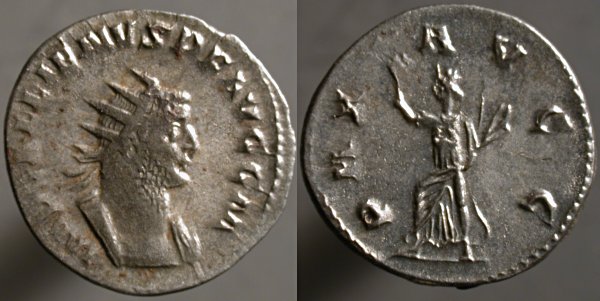
IMP GALLIENVS P F AVG G M, Radiate cuirassed bust right, both ribbons behind | PAX AVGG, Pax advancing left, holding branch left and scepter right.
This obverse was usual at Rome in 257, declaring Gallienus to be Germanicus Maximus.
Friday, September 23, 2005
Æ25, Nicaea in Bithynia, SNG Copenhagen 537
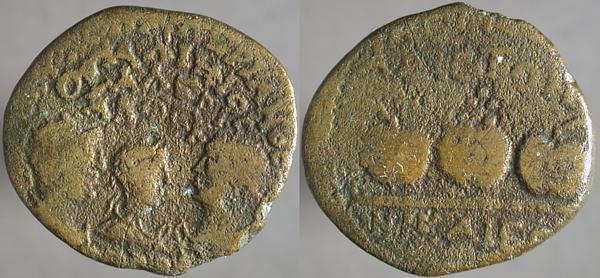
AVT VAΛEPIANOC / ΓAΛΛIHNOC / OYAΛEPI / ANOC // K CEBB, Left to right: radiate bust of Valerian right, radiate bust of Valerian II right, radiate bust of Gallienus left | MEΠIC / TΩN APIC/ TΩN,Three prize crowns with palms. NIKAIEΩN in exergue.
A bit crowded on the obverse, with two emperors and a caesar along with their names. Kinda balances the three crowns on the reverse too, now that I think of it. Mepisto and Aristo, named on the reverse, were presumably magistrates, likely those who financed the games that these crowns served as prizes for.
Thursday, September 22, 2005
Billon antoninianus, Salonina, Rome, Göbl 242b
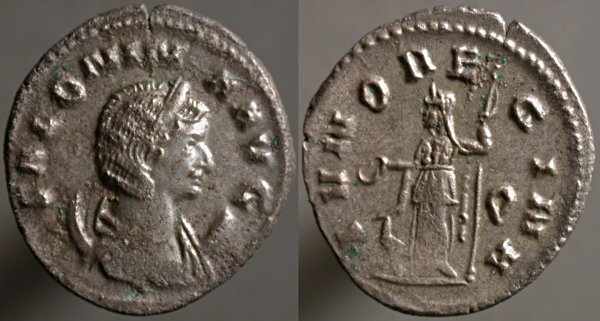
SALONINA AVG, Diademed draped bust right on crescent | IVNO REGINA, Juno standing facing, head left, holding scepter right and patera left. Peacock at feet left. Q in right field.
One of the reasons ancient Roman coins are easier to collect than those of Greece or of other non-classical cultures is that the Latin alphabet is familiar, with no letters which are not also present in English.
The letter Q, though, has changed shape a little and isn't always immediately recognizable. If I had no documentation and no better example, I'd be prone to thinking that the mark in the right of the reverse was a P.
But Q it is.
Wednesday, September 21, 2005
Billon drachm, Indo-Scythian, Azes II, unknown
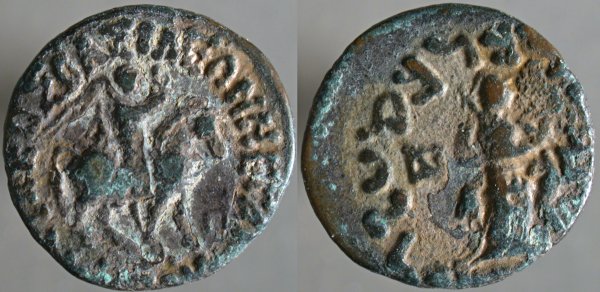
King holding whip, riding horse walking right. Corrupt Greek legend. | Athena standing right with shield and long spear. Karosthi legend.
Azes II reigned in northern India c.35-12 BCE, the last king of the Indo-Scythians who had superseded the Hellenistic successors to Alexander and were themselves supplanted by the Parthians.
Tuesday, September 20, 2005
Æ23, Anazarbus in Cilicia, Gallienus, Ziegler 822
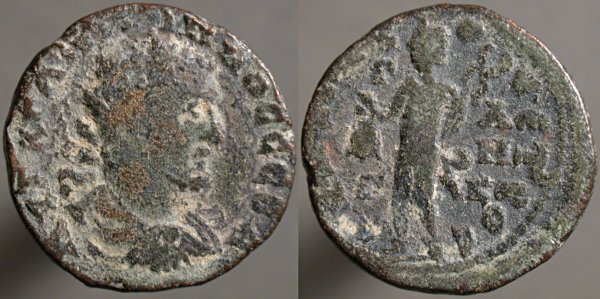
AVT K ΓA[ΛΛ]IHNOC CEBA, Radiate draped cuirassed bust right | AN[AZAPB]_O_V ET BOC, Hermes standing facing, head left, holding purse left and caduceus right. Γ/Γ in left field, A/M/K in right field.
I've noticed many Anazarbus coins on the market right now. I don't know if they're from a large collection that got sold, a group of coins newly excavated, or if it's just coincidence, but it's certainly not uncommon for relatively large numbers of similar coins to appear for sale at once.
While I can't find this coin in any of the catalogs I have that include Anazarbus, a glance at the bust made me think of that city, and of the some of the coins it issued for Valierian.
The seller's photo clearly showed ET BOC at the end of the reverse legend. Well known to me, that's the date of the coin, year 272 since the incorporation of the city into the Roman empire in 19 BCE, so 253-254 by our calendar, when Anazarbus issued coins for Valerian and Gallienus.
Before posting, I sought and received help, and found a catalog reference.
Monday, September 19, 2005
Æ antoninianus, Gallienus, Rome, Göbl 732b
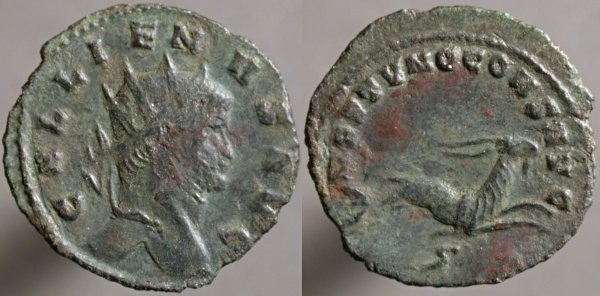
GALLIENVS AVG, Radiate head right | NEPTVNO CONS AVG, Capricorn swimming right. Digamma in exergue.
An infrequently-seen entry in the “Zoo series,” this shows one of the mythological animal reverses, a sea-going goat in the Western zodiac. The association of a sea-creature with Neptune seems obvious, but I don't see it made in the tales of Capricorn.
Sunday, September 18, 2005
Æ drachm, Alexandria, Gallienus, Emmett 3842(12)

AVT K Π ΛIK ΓAΛΛIHNOC CEB, Laureate cuirassed bust right | LIB, Eagle standing left, head right, wreath in beak. Palm in left field, regnal year in right.
At this time, 264-265, the drachm was an infrequently minted coin in Roman Egypt, produced for Gallienus only in this, the twelfth year of his reign. This coin was part of the collection of Professor Thomas Ollive Mabbott, auctioned by the Hans M.F. Schulman firm in 1969. (It brought $15 at the time.)

